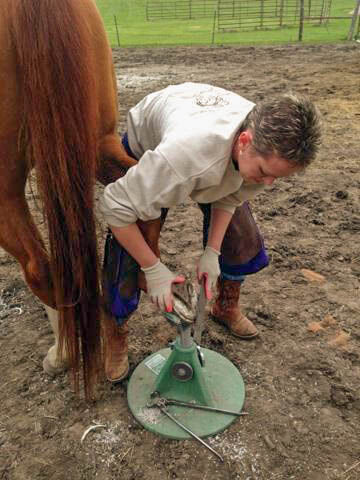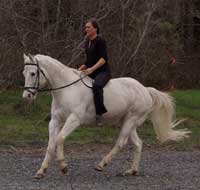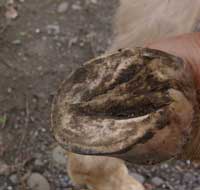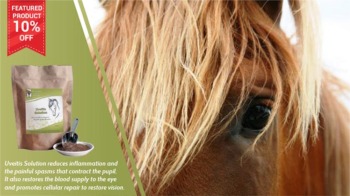The Hoof as a Shock Absorber:
by Melissa Tankersley
 The shock of concussion when a horse’s hoof hits the ground is diffused and dissipated laterally against the hoof wall. It is not transferred vertically to the ground as this would greatly increase concussion and enhance the likelihood of musculoskeletal injuries.
The shock of concussion when a horse’s hoof hits the ground is diffused and dissipated laterally against the hoof wall. It is not transferred vertically to the ground as this would greatly increase concussion and enhance the likelihood of musculoskeletal injuries.
As the foot strikes the ground, downward pressure flattens out the concave surface of the sole. This distributes weight laterally against the hoof wall, which expands about ¼ of an inch, hence the importance of the bars. If the hoof wall formed a continuous ring uninterrupted by the bars, expansion of the hoof could not take place.
With heel pressure, the frog compresses the digital cushion which then flattens and pushes the lateral cartilages outward in the opposite direction. To make room, blood is squeezed out of the coronary plexus.
During concussion, the Navicular bone transfers the load from the digital cushion through to the short pastern bone, bypassing the coffin bone and relieving some of its load.
As weight is removed from the leg, the above structures spring back to their original positions. This is known as contraction. These mechanical aids are very important in preventing musculoskeletal and foot injuries and in maintaining the health and fitness of the horse.
When shoes are applied, the internal structures are not allowed to flex freely and compensate for uneven ground. The shock is no longer able to be absorbed by the hoof, as the shoe does not bend and flex. This increases the likelihood for issues such as arthritis, inflammation and other injuries and will eventually cause problems with growth and strength of the hoof as the circulation is also greatly diminished.
Barefoot Trimming matters to your horse's health:
by Angela Burgess
 Angela Burgess and Ditto cantering
Angela Burgess and Ditto cantering |
 Ditto's hoof
Ditto's hoof |
A true barefoot trim, modeled after a wild horse hoof which has been crafted by nature, is of utmost importance to the overall health of your horse. When the frog and sole connect with the ground they stimulate circulation to the entire hoof. Free from restrictive shoes, the internal structures of the hoof will flex freely compensating for uneven ground and protecting the joints of the leg from injury and inflammation - the most common contributing factor to the development of arthritis as the horse ages. An unshod hoof of a healthy horse will have a better opportunity to exfoliate dead sole and frog material and shed debris with every step making it more difficult for bacterial and fungal infections to become established. The correct barefoot trim that yields these benefits is one that keeps the heels low; the hairline at a 30 degree balance. This will keep the coffin bone ground parallel so it bears the full weight evenly. Heels that are protected by shoes will not wear and thus will grow tall pitching the sharp tip of the coffin bone downward which puts pressure at the sole, pinching the blood supply located there (circumflex artery), and thus compromising the health of the hoof . The barefoot trim will also maintain the correct toe length by allowing the correct break-over in the horse's stride which is vital in preventing the development of Navicular syndrome. The classic "mustang roll" (the bevel of the hoof wall where it meets the ground) prevents flares from developing with the resulting chipping of hoof wall commonly found with horses that receive ordinary barefoot trims referred to as "pasture trims". The natural wear to the hoof of a horse that is barefoot, moving freely throughout the day on various footings including gravel and rocky terrain, will eventually maintain the "mustang barefoot trim" with less and less monthly rasping. Having the correct trim that keeps the break over correct and coffin bone ground parallel is vital for the health and soundness of your horse. For a foundered horse, the correct barefoot trim is not only of utmost importance- it is absolutely vital. Unlike the traditional shoeing method for rehabilitating foundered horses, this method allows for the frequent trimming needed to allow the new hoof to grow down around the present position of the coffin bone resulting in a new and correctly oriented hoof capsule in 6-12 months. It makes it safe for the horse to move during this period because the toe is aggressively backed up and the heels kept low on a weekly basis with minor trims. Stall rest slows recovery while the freedom to choose to walk only speeds the recovery by increasing circulation as well as emotionally stimulating the horse. A stalled foundered horse is a depressed horse. Chronic abscessing that results from undue pressure on the stretched and diseased lamina will be minimized and stops the stretching process that results from the mechanical aspect of peripherally loading a hoof with damaged lamina also will be halted. The importance of this type of trim for any horse, but especially a foundered horse, cannot be emphasized enough.









